Multiview Multistatic vs. Multimonostatic Three-Dimensional Ground-Penetrating Radar Imaging: A Comparison
Abstract
:1. Introduction
2. GPR Imaging Problem
3. Resolution Analysis
3.1. Theoretical Background
3.2. Resolution Analysis
4. Reconstruction Results
5. Conclusions
Author Contributions
Funding
Data Availability Statement
Conflicts of Interest
References
- Daniels, D.J. Ground Penetrating Radar; John Wiley and Sons: Hoboken, NJ, USA, 2005. [Google Scholar]
- Persico, R. Introduction to Ground Penetrating Radar: Inverse Scattering and Data Processing; Wiley: Hoboken, NJ, USA, 2014. [Google Scholar]
- Benedetto, A.; Pajewsky, L. Civil Engineering Applications of Ground Penetrating Radar; Springer: Cham, Switzerland, 2015; ISBN 978-3-319-04813-0. [Google Scholar]
- Catapano, I.; Crocco, L.; Di Napoli, R.; Soldovieri, F.; Brancaccio, A.; Pes, O.F.; Aiello, A. Microwave tomography enhanced GPR surveys in Centaur’s Domus—Regio vI of Pompeii. J. Geophys. Eng. 2012, 9, S92–S99. [Google Scholar] [CrossRef]
- Soldovieri, F.; Brancaccio, A.; Prisco, G.; Leone, G.; Pierri, R. A Kirchhoff-based shape reconstruction algorithm for the multimonostatic configuration: The realistic case of buried pipes. IEEE Trans. Geosci. Remote Sens. 2008, 46, 3031–3038. [Google Scholar] [CrossRef]
- Soliman, M.; Wu, Z. Buried object location based on frequency domain UWB measurements. J. Geophys. Eng. 2008, 5, 221–231. [Google Scholar] [CrossRef]
- Urbini, S.; Cafarella, L.; Marchetti, M.; Chiarucci, P. Fast geophysical prospecting applied to archaeology: Results at villa ai Cavallacci (Albano Laziale, Rome) site. Ann. Geophys. 2007, 50, 291–299. [Google Scholar] [CrossRef]
- Sato, M. MIMO Radar. In MIMO Communications—Fundamental Theory, Propagation Channels, and Antenna Systems; IntechOpen: London, UK, 2023. [Google Scholar] [CrossRef]
- Zhang, W.; Hoorfar, A. MIMO Ground Penetrating Radar Imaging through Multilayered Subsurface Using Total Variation Minimization. IEEE Trans. Geosci. Remote Sens. 2019, 57, 2107–2115. [Google Scholar] [CrossRef]
- Catapano, I.; Gennarelli, G.; Esposito, G.; Ludeno, G.; Su, Y.; Zhang, Z.; Soldovieri, F. Contactless Microwave Tomography via MIMO GPR. IEEE Geosci. Remote Sens. Lett. 2023, 20, 1–5. [Google Scholar] [CrossRef]
- Zheng, W.; Hao, T.; Li, X.; Luo, W. Experimental validation of the horizontal resolution improvement by ultra-wideband metasurfaces for GPR systems. NDT E Int. 2024, 147, 103179. [Google Scholar] [CrossRef]
- Jin, T.; Lou, J.; Zhou, Z. Extraction of Landmine Features Using a Forward-Looking Ground-Penetrating Radar with MIMO Array. IEEE Trans. Geosci. Remote Sens. 2012, 50, 4135–4144. [Google Scholar] [CrossRef]
- Dogaru, T.; Carin, L. Time-domain sensing of targets buried under a rough air-ground interface. IEEE Trans. Antennas Propag. 1998, 46, 360–372. [Google Scholar] [CrossRef]
- Soldovieri, F.; Gennarelli, G.; Catapano, I.; Liao, D.; Dogaru, T. Forward-Looking Radar Imaging: A Comparison of Two Data Processing Strategies. IEEE J. Sel. Top. Appl. Earth Obs. Remote Sens. 2017, 10, 562–571. [Google Scholar] [CrossRef]
- Barbin, Y.; Nicollin, F.; Kofman, W.; Zolotarev, V.; Glotov, V. Mars 96 GPR program. J. Appl. Geophys. 1995, 33, 27–37. [Google Scholar] [CrossRef]
- Hamran, S.E.; Paige, D.A.; Amundsen, H.E.F.; Berger, T.; Brovoll, S.; Carter, L.; Damsgård, L.; Dypvik, H.; Eide, J.; Eide, S.; et al. Radar imager for Mars’ subsurface experiment—RIMFAX. Space Sci. Rev. 2020, 216, 1–39. [Google Scholar] [CrossRef]
- Jing, L.; Chen, Y.; Zeng, Z. Estimated lunar regolith structure based on the least-squares Kirchhoff migration of CE-3 lunar penetrating radar data. IEEE Geosci. Remote. Sens. Lett. 2020, 18, 816–820. [Google Scholar]
- García-Fernández, M.; Álvarez-Narciandi, G.; Laviada, J.; López, Y.Á.; Las-Heras, F. Towards real-time processing for UAV-mounted GPR-SAR imaging systems. ISPRS J. Photogramm. Remote Sens. 2024, 212, 1–12. [Google Scholar] [CrossRef]
- Catapano, I.; Crocco, L.; Isernia, T. A simple two-dimensional inversion technique for imaging homogeneous targets in stratified media. Radio Sci. 2004, 39, 1–14. [Google Scholar] [CrossRef]
- Hajebi, M.; Tavakoli, A.; Dehmollaian, M.; Dehkhoda, P. An Iterative Modified Diffraction Tomography Method for Reconstruction of a High-Contrast Buried Object. IEEE Trans. Geosci. Remote Sens. 2018, 56, 4138–4148. [Google Scholar] [CrossRef]
- Fischer, C.; Younis, M.; Wiesbeck, W. Multistatic GPR data acquisition and imaging. Proc. IEEE Int. Geosci. Remote Sens. Symp. 2002, 1, 328–330. [Google Scholar]
- Counts, T.; Gurbuz, A.C.; Scott, W.R.; McClellan, J.H.; Kangwook, K. Multistatic ground-penetrating radar experiments. IEEE Trans. Geosci. Remote Sens. 2007, 45, 2544–2553. [Google Scholar] [CrossRef]
- Nikolova, N.K. References. In Introduction to Microwave Imaging; EuMA High Frequency Technologies Series; Cambridge University Press: Cambridge, UK, 2017; pp. 327–340. [Google Scholar]
- Pastorino, M. Microwave Imaging; John Wiley and Sons: Hoboken, NJ, USA, 2010. [Google Scholar]
- Chew, W.C. Inverse Scattering Problems. In Waves and Fields in Inhomogenous Media; IEEE: Piscataway, NJ, USA, 1995; pp. 511–570. [Google Scholar] [CrossRef]
- Persico, R. On the role of measurement configuration in contactless GPR data processing by means of linear inverse scattering. IEEE Trans. Geosci. Remote Sens. 2006, 54, 2062–2071. [Google Scholar] [CrossRef]
- Noghanian, S.; Sabouni, A.; Desell, T.; Ashtari, A. Microwave Tomography; Springer: New York, NY, USA, 2014. [Google Scholar]
- Catapano, I.; Gennarelli, G.; Ludeno, G.; Soldovieri, F.; Persico, R. Ground-Penetrating Radar: Operation Principle and Data Processing. In Wiley Encyclopedia of Electrical and Electronics Engineering; Wiley: Hoboken, NJ, USA, 2019; pp. 1–23. [Google Scholar]
- Almeida, E.R.; Bicudo, T.; Porsani, J.L. Automatic estimation of inversion parameters for Microwave Tomography in GPR data using cooperative targets. J. Appl. Geophys. 2020, 178, 104074. [Google Scholar] [CrossRef]
- Ambrosanio, M.; Bevacqua, M.T.; Isernia, T.; Pascazio, V. Performance Analysis of Tomographic Methods Against Experimental Contactless Multistatic Ground Penetrating Radar. IEEE J. Sel. Top. Appl. Earth Obs. Remote. Sens. 2021, 14, 1171–1183. [Google Scholar] [CrossRef]
- Gennarelli, G.; Catapano, I.; Ludeno, G.; Noviello, C.; Papa, C.; Pica, G.; Soldovieri, F.; Alberti, G. A low frequency airborne GPR system for wide area geophysical surveys: The case study of Morocco Desert. Remote. Sens. Environ. 2019, 233, 111409. [Google Scholar] [CrossRef]
- Soldovieri, F.; Persico, R.; Leone, G. A linear inverse scattering algorithm for the multi-monostatic GPR configuration. In Proceedings of the 3rd International Workshop on Advanced Ground Penetrating Radar, Delft, The Netherlands, 2–3 May 2005. [Google Scholar]
- Bhat, C.; Maisto, M.A.; Khankhoje, U.K.; Solimene, R. Subsurface Radar Imaging by Optimizing Sensor Locations in Spatio-Spectral Domains. IEEE Trans. Geosci. Remote. Sens. 2023, 61, 4505310. [Google Scholar] [CrossRef]
- Salucci, M.; Poli, L.; Massa, A. Advanced multi-frequency GPR data processing for non-linear deterministic imaging. Signal Process. 2017, 132, 306–318. [Google Scholar] [CrossRef]
- Gennarelli, G.; Catapano, I.; Soldovieri, F.; Persico, R. On the Achievable Imaging Performance in Full 3-D Linear Inverse Scattering. IEEE Trans. Antennas Propag. 2015, 63, 1150–1155. [Google Scholar] [CrossRef]
- Maisto, M.A.; Masoodi, M.; Pierri, R.; Solimene, R. Sensor Arrangement in Through-the Wall Radar Imaging. IEEE Open J. Antennas Propag. 2022, 3, 333–341. [Google Scholar] [CrossRef]
- Oliveri, G.; Anselmi, N.; Massa, A. Compressive sensing imaging of non-sparse 2D scatterers by a total-variation approach within the Born approximation. IEEE Trans. Antennas Propag. 2014, 62, 5157–5170. [Google Scholar] [CrossRef]
- Feng, X.; Sato, M. Pre-stack migration applied to GPR for landmine detection. Inverse Probl. 2004, 20, S99. [Google Scholar] [CrossRef]
- Devaney, A.J. Geophysical diffraction tomography. IEEE Trans. Geosci. Remote Sens. 1984, 1, 3–13. [Google Scholar] [CrossRef]
- Cui, T.J.; Chew, W.C. Diffraction tomographic algorithm for the detection of three-dimensional objects buried in a lossy half-space. IEEE Trans. Antennas Propag. 2002, 50, 42–49. [Google Scholar]
- Bertero, M.; Boccacci, P.; De Mol, C. Introduction to Inverse Problems in Imaging, 2nd ed.; CRC Press: Boca Raton, FL, USA, 2021. [Google Scholar] [CrossRef]
- Hansen, P.C.; Jensen, T.K.; Rodriguez, G. An adaptive pruning algorithm for the discrete L-curve criterion. J. Comput. Appl. Math. 2007, 198, 483–492. [Google Scholar] [CrossRef]
- Castellanos, J.L.; Gómez, S.; Guerra, V. The triangle method for finding the corner of the L-curve. Appl. Numer. Math. 2002, 43, 359–373. [Google Scholar] [CrossRef]
- Balanis, C.A. Advanced Engineering Electromagnetics; John Wiley & Sons: Hoboken, NJ, USA, 2012. [Google Scholar]
- Hansen, P.C. Regularization tools version 4.0 for Matlab 7.3. Numer. Algorithms 2007, 46, 189–194. [Google Scholar] [CrossRef]
- Gianluca, G.; Soldovieri, F. Radar imaging through cinderblock walls: Achievable performance by a model-corrected linear inverse scattering approach. IEEE Trans. Geosci. Remote Sens. 2014, 52, 6738–6749. [Google Scholar]
- Gennarelli, G.; Riccio, G.; Solimene, R.; Soldovieri, F. Radar imaging through a building corner. IEEE Trans. Geosci. Remote Sens. 2014, 52, 6750–6761. [Google Scholar] [CrossRef]
- Negishi, T.; Gennarelli, G.; Soldovieri, F.; Liu, Y.; Erricolo, D. Radio frequency tomography for nondestructive testing of pillars. IEEE Trans. Geosci. Remote Sens. 2020, 58, 3916–3926. [Google Scholar] [CrossRef]
- Warren, C.; Giannopoulos, A.; Giannakis, I. gprMax: Open source software to simulate electromagnetic wave propagation for Ground Penetrating Radar. Comput. Phys. Commun. 2016, 209, 163–170. [Google Scholar] [CrossRef]

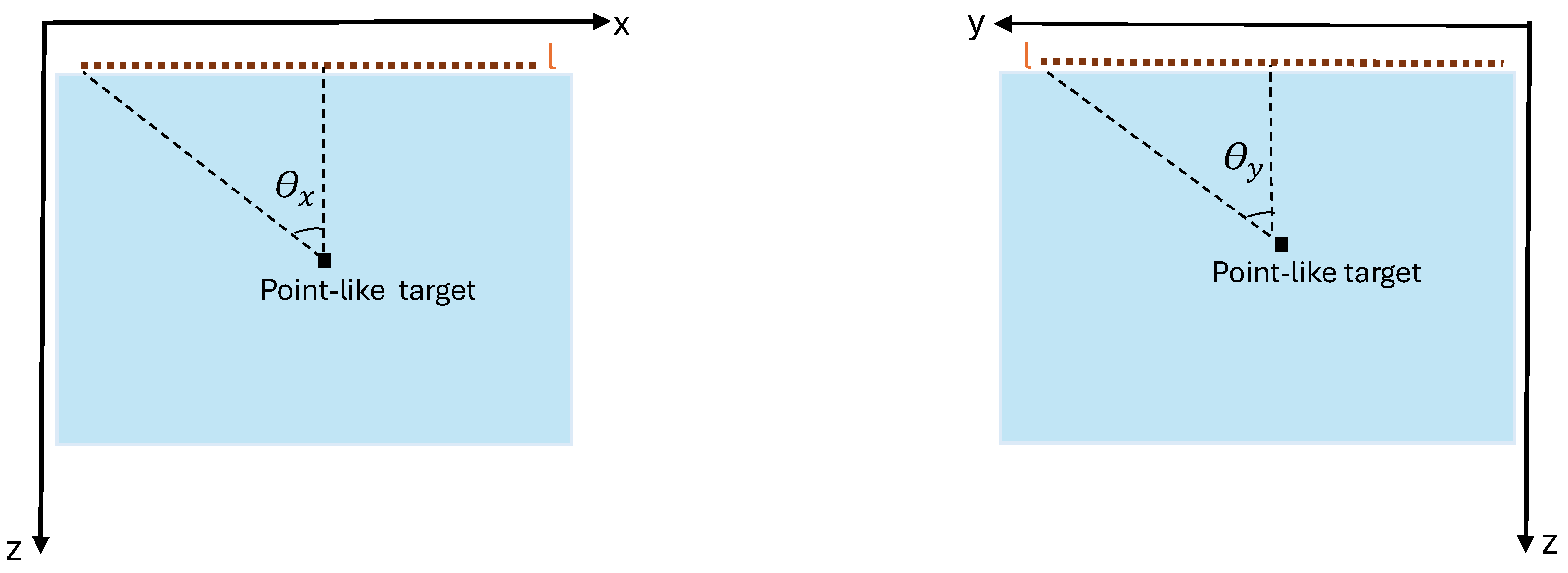


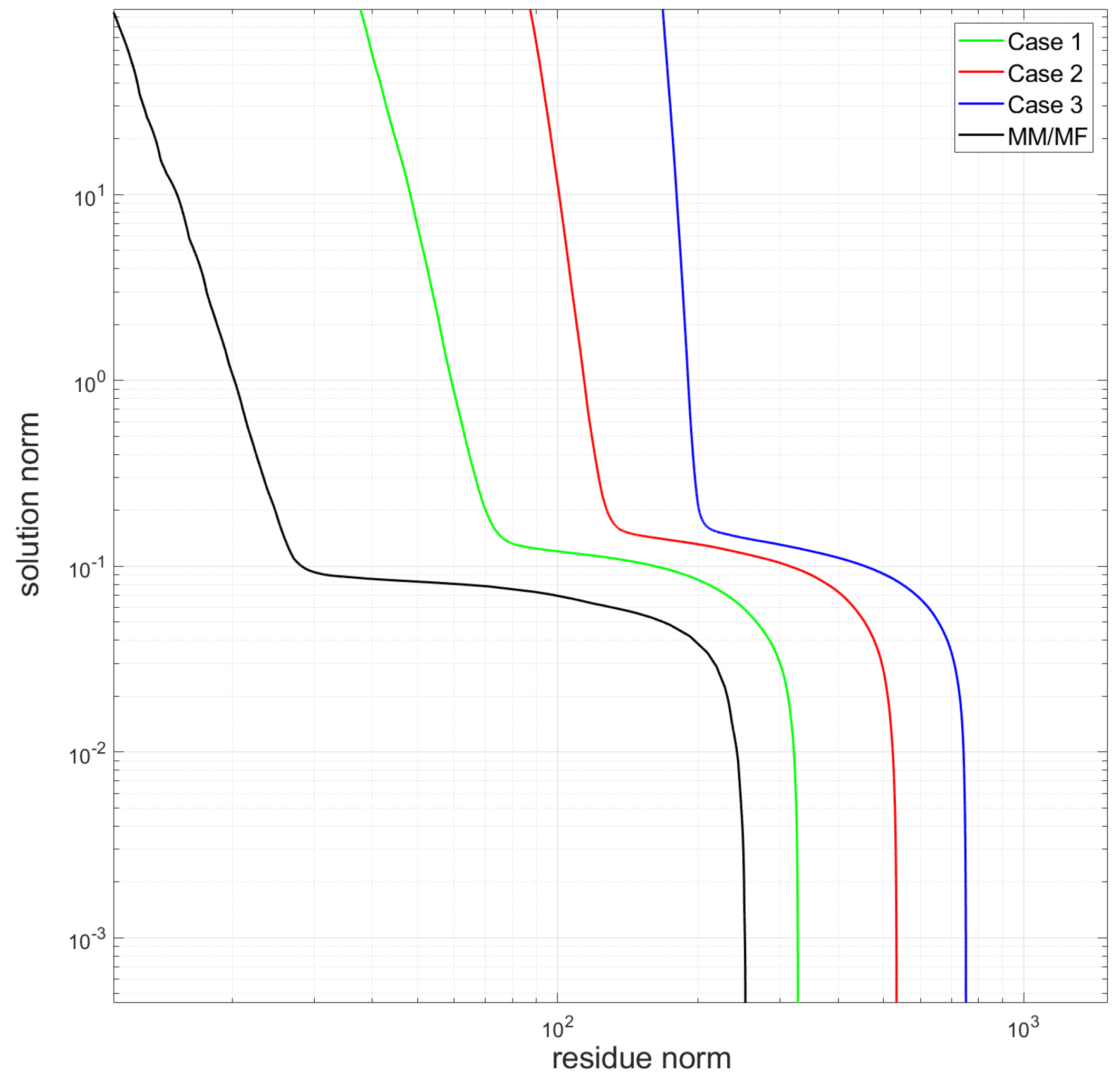
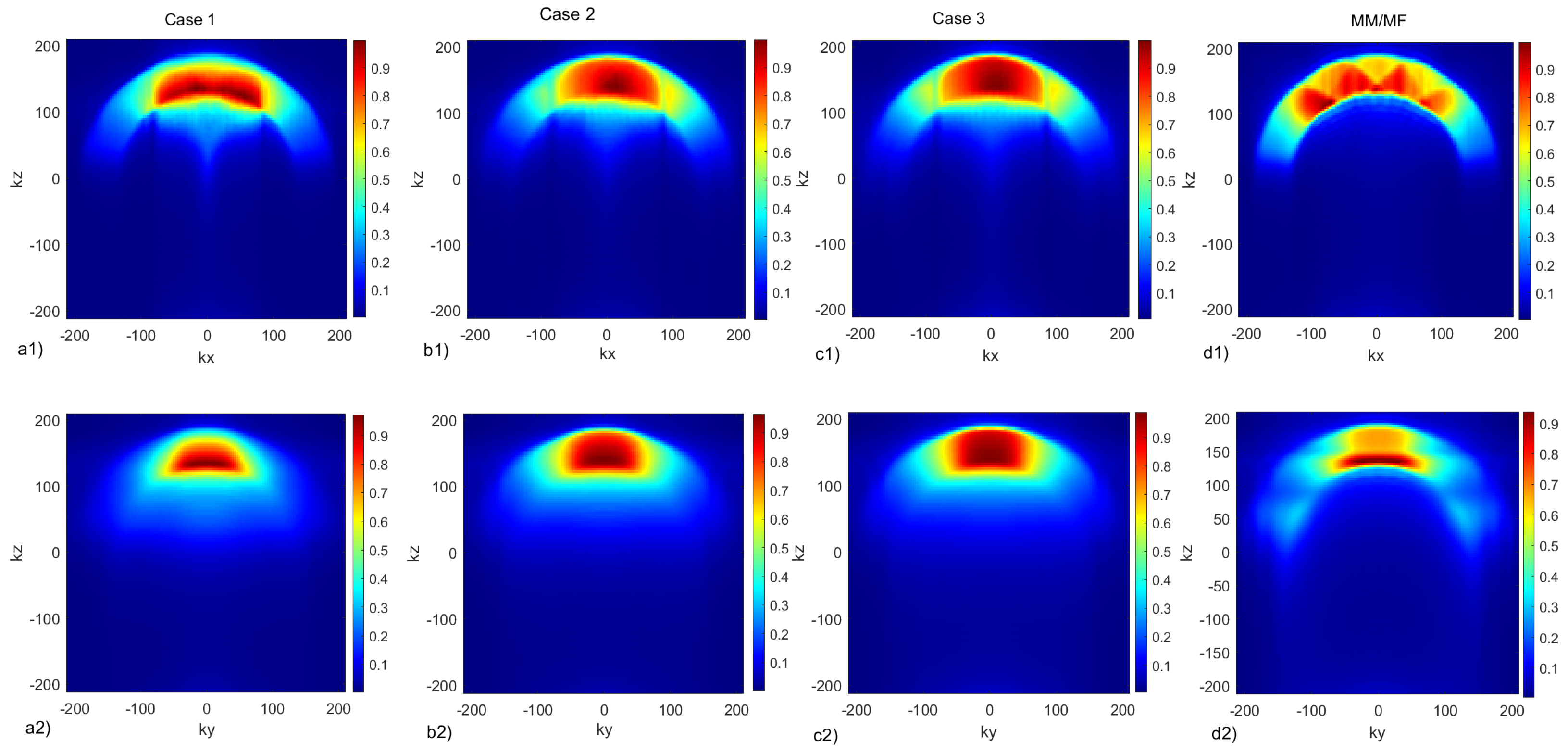
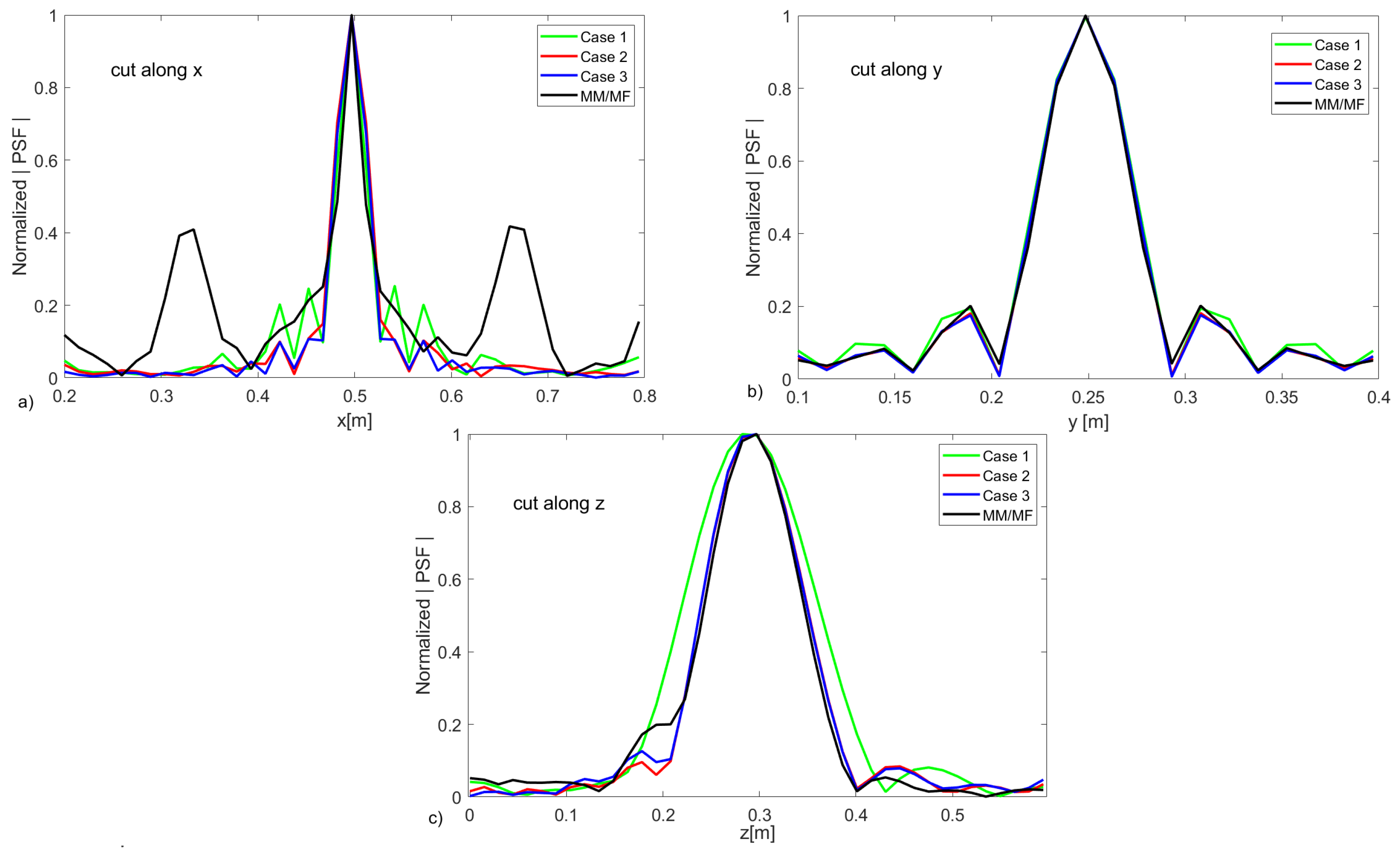

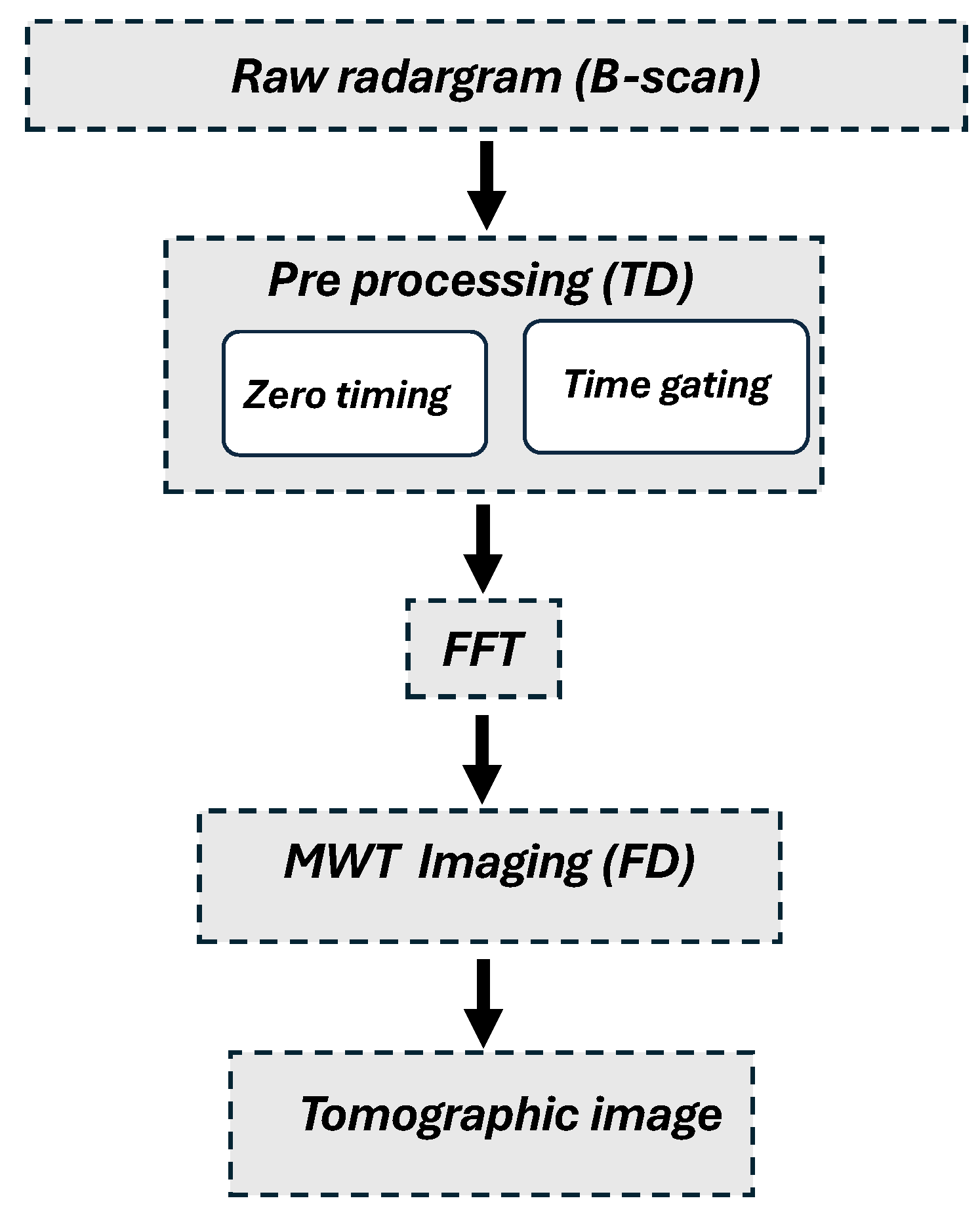
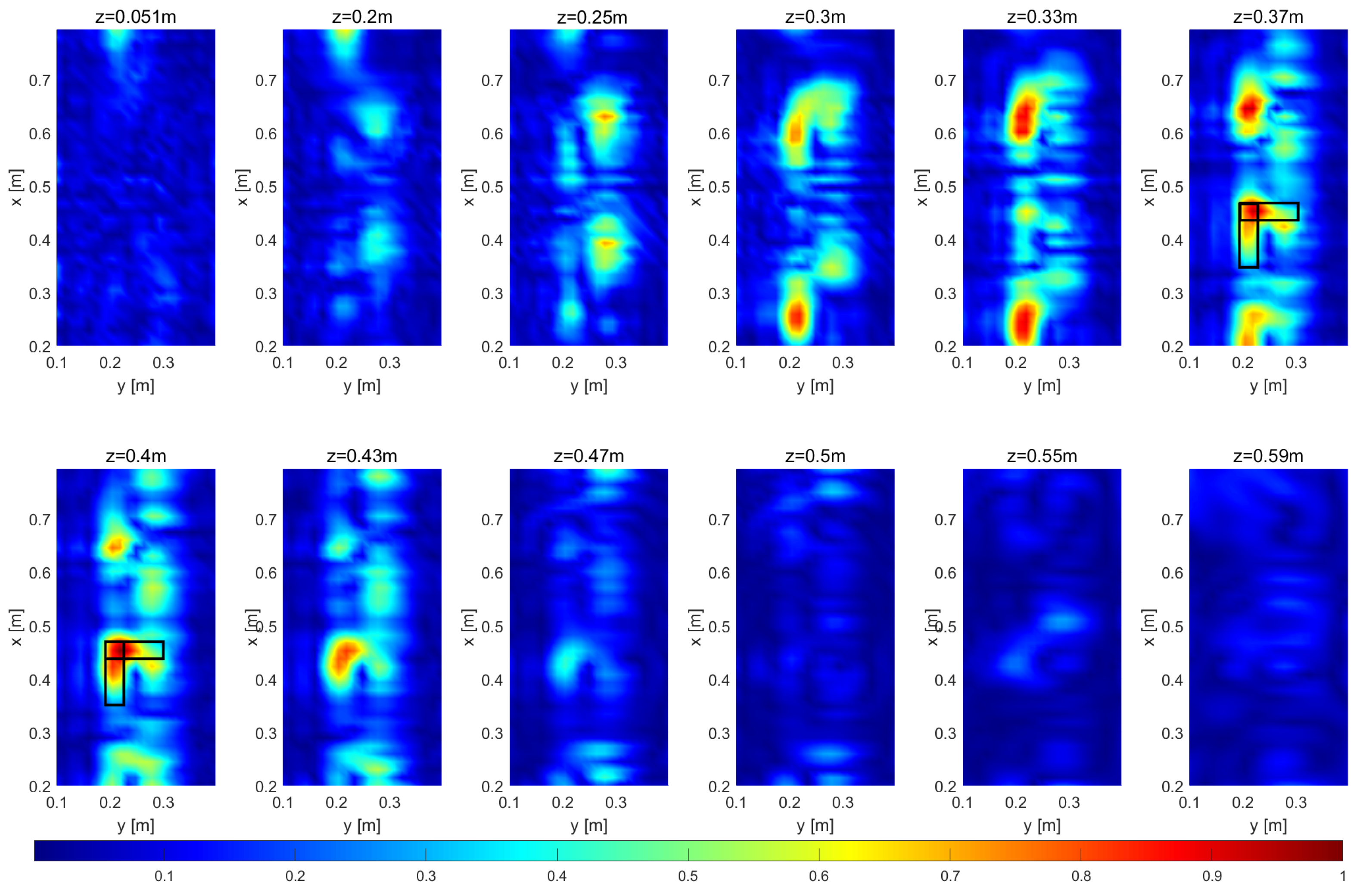
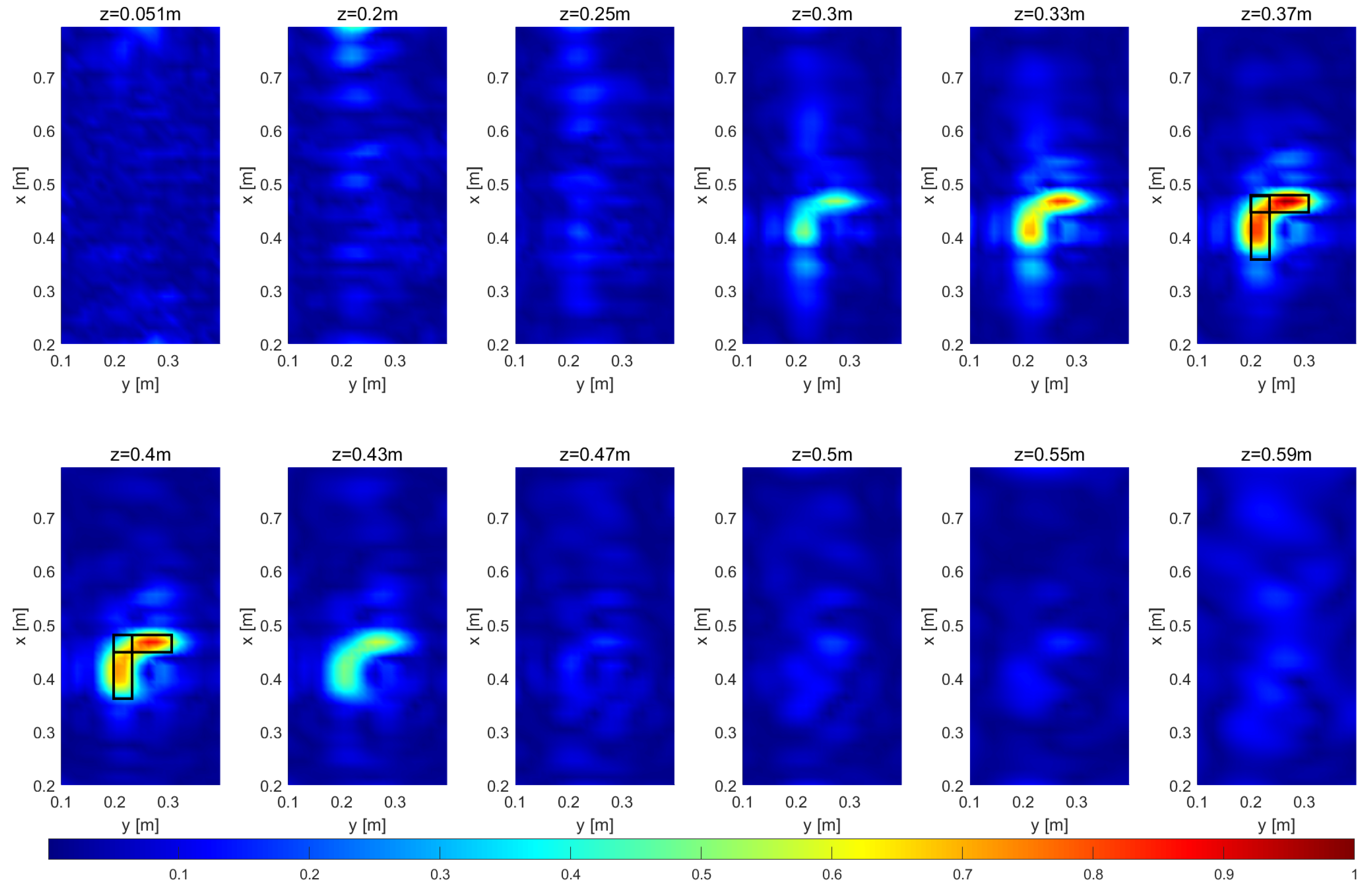
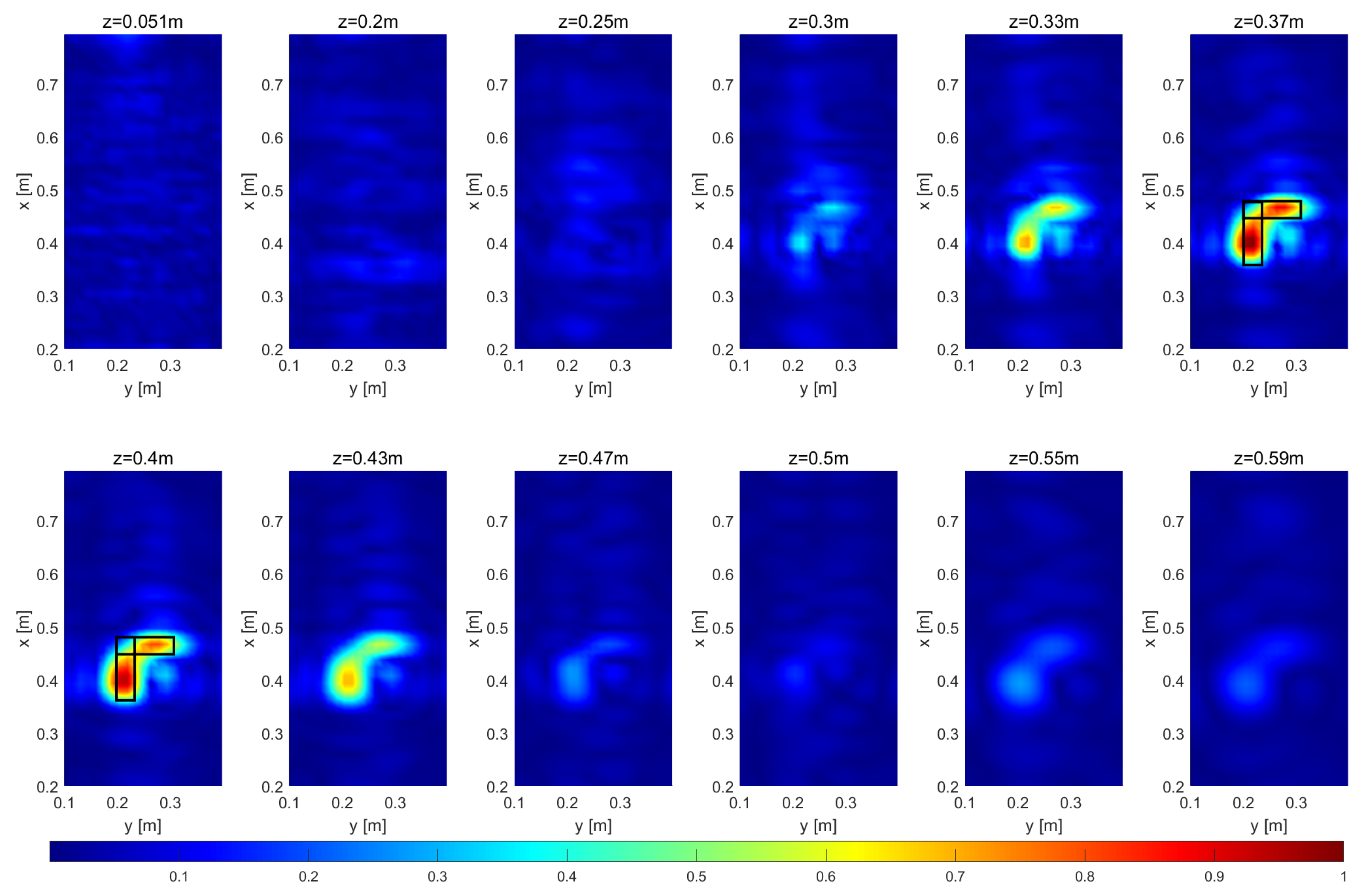
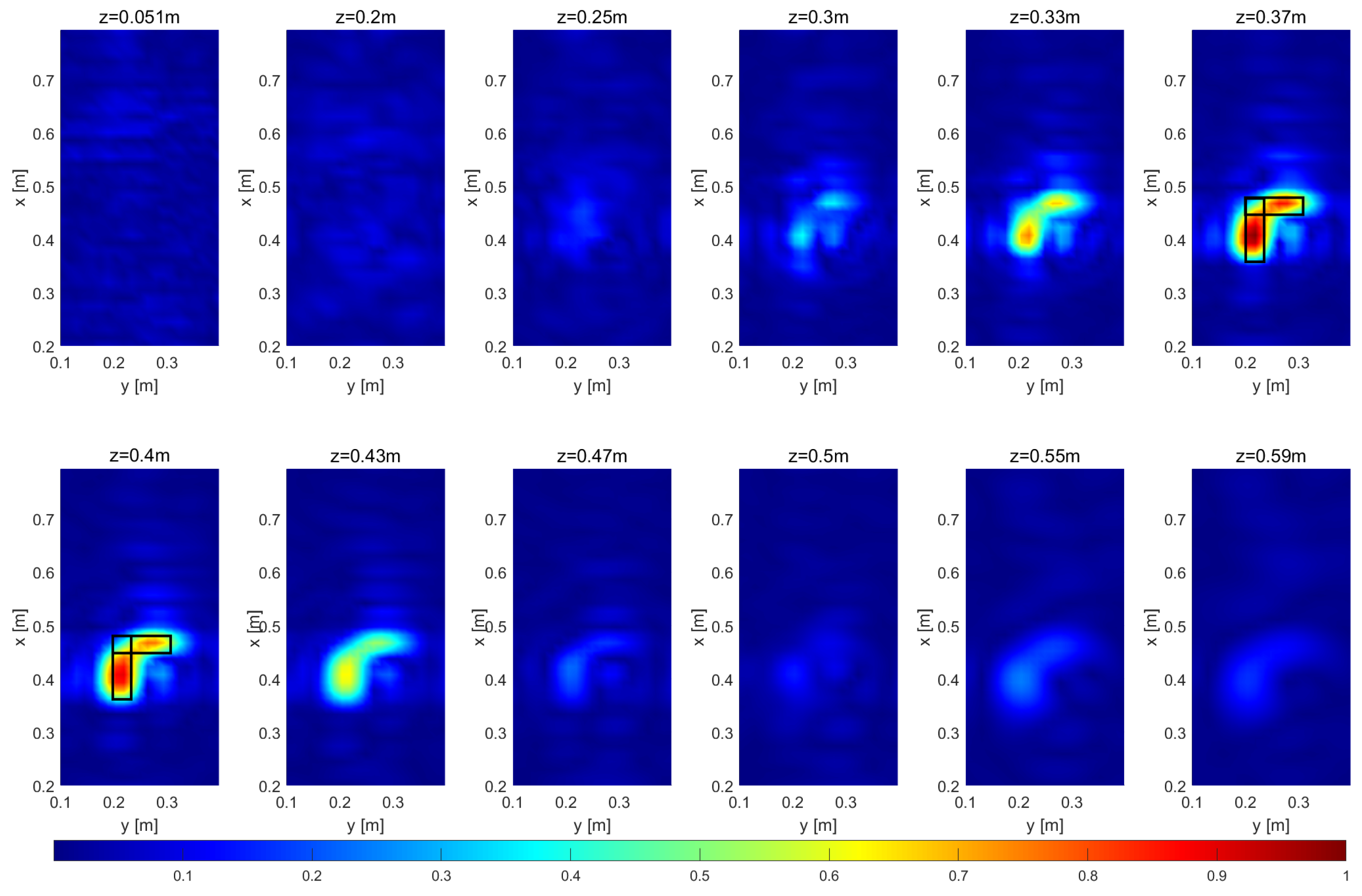
| SNR [dB] | 0 | 5 | 10 | 15 | 20 | 25 | 30 | 35 | 40 | 50 | |
|---|---|---|---|---|---|---|---|---|---|---|---|
| Case 1 | 605 | 714 | 866 | 994 | 1095 | 1194 | 1306 | 1404 | 1476 | 1648 | |
| Case 2 | 929 | 1077 | 1317 | 1488 | 1655 | 1844 | 1999 | 2169 | 2333 | 2600 | |
| Case 3 | 1008 | 1138 | 1474 | 1741 | 1963 | 2176 | 2415 | 2570 | 2797 | 3157 | |
| MM/MF | 338 | 530 | 567 | 723 | 756 | 796 | 847 | 887 | 916 | 973 |
| Resolution | Theoretical (MM/MF) [m] | Case 1 [m] | Case 2 [m] | Case 3 [m] | MM/MF [m] |
|---|---|---|---|---|---|
| 0.02 | 0.02 | 0.02 | 0.02 | 0.02 | |
| 0.04 | 0.04 | 0.04 | 0.04 | 0.04 | |
| 0.1 | 0.1 | 0.08 | 0.08 | 0.08 |
Disclaimer/Publisher’s Note: The statements, opinions and data contained in all publications are solely those of the individual author(s) and contributor(s) and not of MDPI and/or the editor(s). MDPI and/or the editor(s) disclaim responsibility for any injury to people or property resulting from any ideas, methods, instructions or products referred to in the content. |
© 2024 by the authors. Licensee MDPI, Basel, Switzerland. This article is an open access article distributed under the terms and conditions of the Creative Commons Attribution (CC BY) license (https://creativecommons.org/licenses/by/4.0/).
Share and Cite
Masoodi, M.; Gennarelli, G.; Soldovieri, F.; Catapano, I. Multiview Multistatic vs. Multimonostatic Three-Dimensional Ground-Penetrating Radar Imaging: A Comparison. Remote Sens. 2024, 16, 3163. https://doi.org/10.3390/rs16173163
Masoodi M, Gennarelli G, Soldovieri F, Catapano I. Multiview Multistatic vs. Multimonostatic Three-Dimensional Ground-Penetrating Radar Imaging: A Comparison. Remote Sensing. 2024; 16(17):3163. https://doi.org/10.3390/rs16173163
Chicago/Turabian StyleMasoodi, Mehdi, Gianluca Gennarelli, Francesco Soldovieri, and Ilaria Catapano. 2024. "Multiview Multistatic vs. Multimonostatic Three-Dimensional Ground-Penetrating Radar Imaging: A Comparison" Remote Sensing 16, no. 17: 3163. https://doi.org/10.3390/rs16173163





